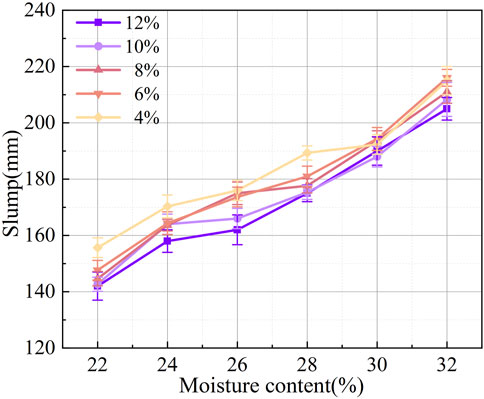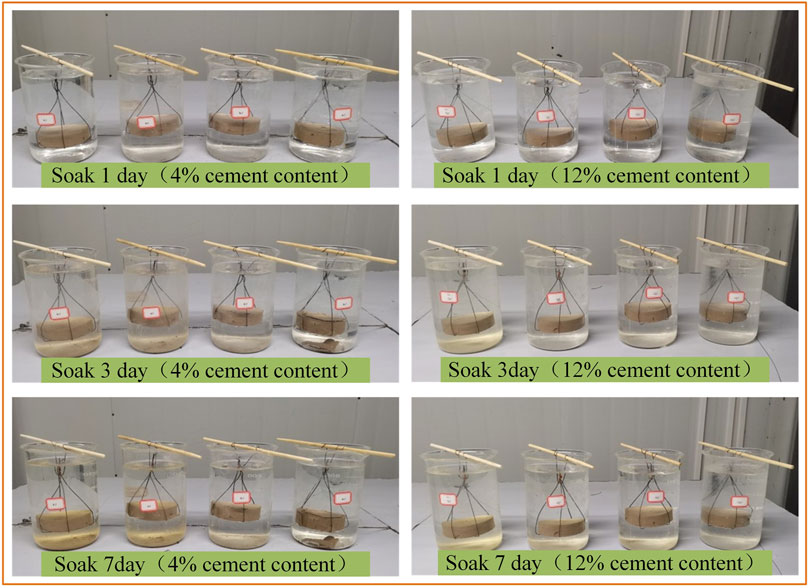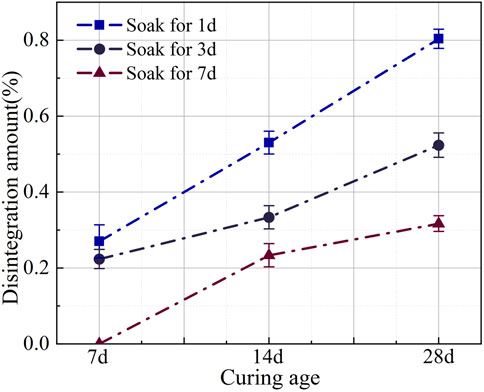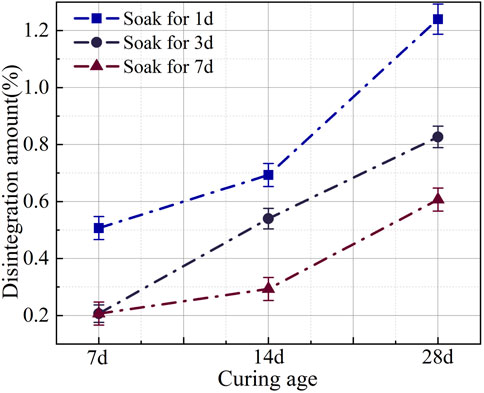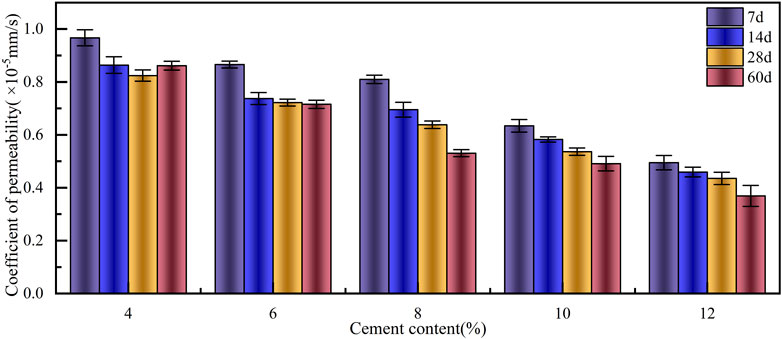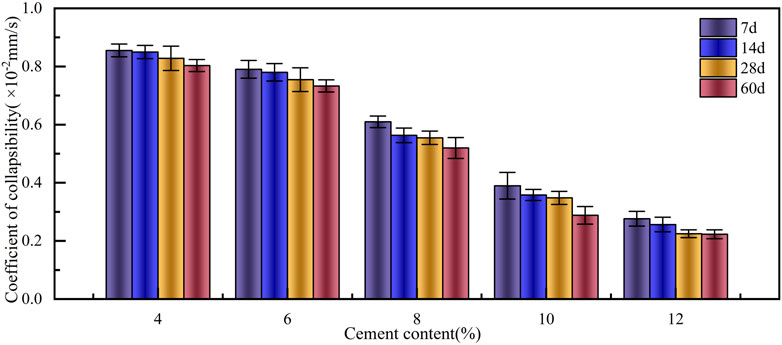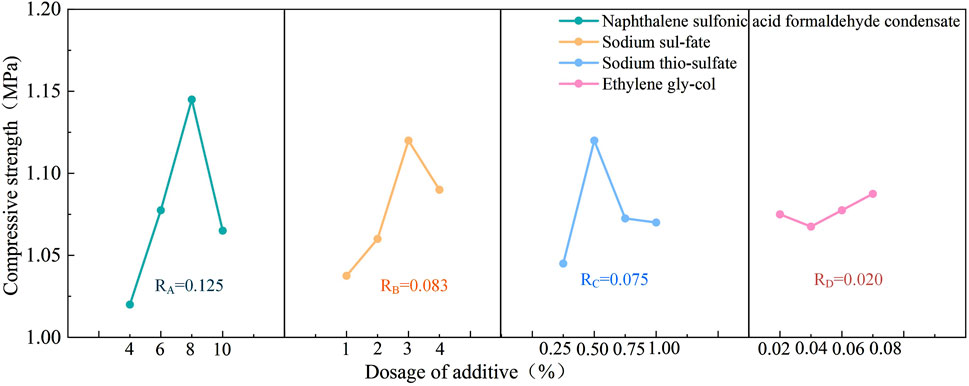- 1Gansu CSCEC Municipal Engineering Investigation and Design Institute Co., Ltd, Lanzhou, Gansu, China
- 2Gansu Civil Aviation Airport Group Co., Ltd., Lanzhou, Gansu, China
- 3School of Civil Engineering, Lanzhou University of Technology, Lanzhou, Gansu, China
To address the challenges of limited space, quality control issues, and ensuring stable self-compaction of backfill materials in trench backfilling projects, a loess-based cement slurry was developed as a flowable backfill material by using loess as the primary base material and incorporating an appropriate amount of admixture for solidification and improvement. The permeability, collapsibility, and disintegration of the loess-based cement slurry were analyzed by varying the cement content and curing age. The slump test was first conducted to determine the optimal water content for varying cement contents, aiming for a slump of 180 mm. Subsequently, the compressive strength was tested using an orthogonal experimental design. The analysis revealed the optimal mix ratio for the loess-based cement slurry: 8% naphthalene sulfonate formaldehyde condensate, 3% sodium sulfate, 0.5% sodium thiosulfate, and 0.08% ethylene glycol. Experimental results indicated that with 4% cement content, the loess-based cement slurry exhibited a maximum permeability coefficient of 0.977 × 10−5 and a maximum collapsibility coefficient of 0.865 × 10−2, confirming that both permeability and collapsibility meet the required standards. When the cement content exceeds 6%, the cement paste shows minimal collapse. This study offers an efficient and reliable technical solution for backfilling operations in loess regions.
1 Introduction
In the northwest region, traditional construction methods face several challenges, including a cumbersome process, difficulty controlling backfill quality, and limited construction space. Therefore, there is an urgent need for a backfill material that is easy to work with, has good fluidity, and can achieve a high degree of compaction. The foundation in this area is primarily composed of loess, a widely distributed soil type. Loess has unique characteristics, including significant collapsibility, relatively weak cohesion, low porosity, and poor plasticity (Song et al., 2021; Liu et al., 2025; Yang et al., 2021). To address these issues, researchers have begun incorporating additives, particularly stabilizers, into loess to improve its engineering properties (Xue et al., 2024a; Nazari et al., 2021; Li et al., 2024; Xue et al., 2024b; Zhou et al., 2023). This approach aims to enhance the stability and strength of the backfill material, thereby addressing the challenges of traditional construction methods.
Currently, researchers employ a variety of methods to improve loess. In terms of lime-improved loess (Sui et al., 2020), used lime to improve the loess in Qingyang area, and studied the permeability characteristics of loess under different lime content. It was found that the permeability coefficient of the improved loess increased with the in-crease of void ratio. Additives to improve cement soil (Ma and Chen, 2021). Combined the un-confined compressive strength and ultimate water content of solidified loess, analyzed the evolution mechanism of mineral composition and microstructure of solidified loess with the change of curing period, and clarified the mechanism of quicklime-solidified loess. Yu et al. (2023) studied the effect of hydroxyl lignin on cement solidified soil with sodium silicate and lime as activators. In the aspect of geopolymer modified loess, in order to solve the problems of low strength, durability and environmental protection of traditional loess curing agent (Zhao et al., 2021a), studied the engineering performance of sodium silicate alkali activated fly ash geopolymer solidified loess through compaction test, unconfined compressive strength test, direct shear test and disintegration test. Bai et al. (2023a) used red mud and fly ash as raw materials to prepare high-strength geopolymer under the action of alkali activator, and studied the effects of high temperature and sodium hydroxide on the strength of the geopolymer. Li et al. (2023) developed a high-strength geopolymer curing material with green steel slag fly ash as the main component, and studied the mechanical properties and microstructure changes of loess under different steel slag-fly ash geopolymer dosage and curing age. Wang et al. (2024) used carbide slag, desulfurization gypsum and slag multi-source solid waste as the main cementitious components to prepare geopolymer reinforced loess (Yang et al., 2024). solidified saline loess with geopolymers produced by alkali-activated industrial waste. The mechanical properties, microstructure characteristics and solidification mechanism of geopolymer solidified saline loess were systematically studied by orthogonal test design. In the aspect of microbial solidified soil (Sun et al., 2021), solidified loess by microbial induced carbonate precipitation method. Bai et al. (2024b) used urease combined with biochar technology to treat Pb2 + contaminated sand column, and it was found that urease combined with biochar technology had a good solidification effect on Pb2 +. The effects of guar gum content, basalt fiber content and basalt fiber length on the permeability and disintegration characteristics of solidified loess were analyzed by (Xi et al., 2024). In addition (Wang et al., 2022), used environmentally friendly magnesium oxychloride cement as soil curing agent to prepare solidified soil, and explored the best ratio of various raw materials when using magnesium oxychloride cement as curing agent (Zhu et al., 2023). Takes the solidified waste soft soil as the research object, predicts the best ratio of calcium carbide slag and plant ash, and determines the best ratio of calcium carbide slag and plant ash composite curing agent. Many researchers have carried out field tests on the developed solidified soil materials (Hessouh et al., 2023). Compared the indoor mix ratio test with the deep soil mixing test results of three different construction sites, and established the relationship between the physical and mechanical properties of laboratory materials and construction site materials. The compressive strength, dynamic elastic modulus, porosity and hydraulic permeability were studied by deep mixing method and trench mixing method respectively. Yuan et al. (2023) conducted laboratory tests and field evaluation tests on the erosion resistance of solidified soil. On the self-developed anti-erosion test system, the clear water and muddy water erosion tests were carried out, and the earth-rock dam test dam was built with solidified soil as the material, and the field erosion test was carried out, and the corresponding hydraulic factors were analyzed. Finally, the safety inspection of the dam structure was carried out (Ye et al., 2021). Proposed a new binder for stabilizing soft soil based on industrial solid waste. A series of laboratory tests and field tests were carried out to compare and analyze the geotechnical performance evaluation of GS binder and cement on soft soil.
In summary, using additives to solidify loess can enhance its engineering performance, including its bearing capacity and stability. However, further research is needed to optimize additive selection and processing methods for more effective application of solidified loess in engineering construction. Most research focuses on the impact of additives or cement on loess performance. Most studies examine only one aspect of loess performance, without exploring multiple factors.
Given these research gaps and challenges, the combined effect of additives and cement on loess has been evaluated. By analyzing loess properties such as disintegration, fluidity, and compressive strength, a loess-based cement slurry material for trench and subgrade backfill is proposed. This provides a more practical solution for engineering construction and further advances loess solidification technology.
2 Materials and methods
2.1 Materials
The loess used in the test is taken from Pengjiaping area, Lanzhou City, Gansu Province. The soil is uniform, and the basic physical properties of loess are shown in Table 1 cement is the ordinary Portland cement of Qilianshan brand purchased locally in Lanzhou City. The grade is P.O42.5, which is gray and powder. The composition of cement is shown in Table 2. The test water is Lanzhou tap water. Naphthalenesulfonic acid formaldehyde condensate is a kind of concrete superplasticizer, which is yellowish brown and powder. Sodium sulfate is a kind of concrete early strength agent, which is white and powder. Sodium thiosulfate is a kind of concrete early strength agent, which is colorless and transparent monoclinic crystal. Ethylene glycol is a kind of concrete antifreeze, colorless and liquid.
2.2 Sample preparation methods
Refer to the (Ministry of housing and urban-rural developmentof the people’s republic of China, 2011). (1) Weigh the loess, water, and cement required for the sample, then place them into the mixer. Stir the mixture for 2–3 min, followed by adding the required amount of water and mixing for an additional 10 min before loading the mold.; (2) Install the mold in two stages. After each installation, insert the rammer evenly and vibrate on the vibration table for 20 s; (3) Prepare the ring knife sample for the disintegration test. After vibrating the test mold, insert the ring knife slowly, ensuring the top of the knife is at least 5 mm below the upper edge of the mold. Remove any excess loess-based cement slurry from the top of the mold using a knife; (4) Cover the surface of the test mold with a layer of plastic film. Place the mold in a curing box set at 20°C ± 2 °C and more than 95% humidity for curing. Once the specified curing time has passed, proceed with the relevant tests. The preparation process of loess-based cement slurry is shown in Figure 1.
2.3 Slump test
Referring to the (China Association for Engineering Construction Standardization, 2022) and the actual engineering requirements, the optimum slump of loess-based cement slurry is determined to be 180 mm. The slump test is used to determine the optimum water content when the slump of loess-based cement slurry is 180 mm, which lays a foundation for the subsequent orthogonal test. The test steps are as follows: (1) The water content is preset to 22%, 24%, 26%, 28%, 30%, and 32%, and the cement content is set to 4%, 6%, 8%, 10%, and 12%, respectively. (2) The finished loess-based cement slurry was uniformly loaded into the collapse cylinder in three times. Clean the excess slurry around the cylinder with a scraper, and then lift the collapse cylinder immediately, which is completed in 5–10 s (3) Put the collapse tube beside the loess-based cement slurry material, put a ruler facing the mixture on the top of the tube, and measure the vertical distance from the bottom of the ruler to the highest point of the sample, that is, the slump of the mixture. All the slumps in the test need to be tested three times.
2.4 Disintegration test
A disintegration test was conducted on loess-based cement slurry with varying cement contents, as determined by the slump test. The wetting and disintegration behavior of the sample in water was observed to evaluate the water stability characteristics of the loess-based cement slurry. The optimal cement content was identified, providing parameters for the subsequent orthogonal test. The test steps are as follows: First, the sample is dried to constant weight in a drying oven, and its initial mass is recorded. A beaker filled with distilled water is prepared, and the sample, having reached the curing age, is fully immersed. The samples are then removed at intervals, and the surface moisture is dried using filter paper. The samples are weighed, and the disintegration behavior is recorded.
2.5 Permeability test
The permeability of loess-based cement slurry is an important property as well as the strength and deformation characteristics. The permeability coefficient is a quantitative index representing the permeability of loess-based cement slurry, and it is also a necessary physical quantity in permeability calculation. The samples were prepared with cement content of 4%, 6%, 8%, 10% and 12%. The permeability test of loess-based cement slurry samples was carried out after the curing age reached 7d, 14d, 28d and 60d, and the impermeability of loess-based cement slurry was analyzed.
According to (Ministry of housing and urban-rural development of the people’s republic of China, 2019), the variable head permeability test is based on Darcy's law and mass conservation principle. It is a test method for measuring the permeability coefficient of low permeability materials. Different from the constant head permeability experiment, the variable head experiment calculates the permeability coefficient by measuring the change of the head with time, which is suitable for the medium with low permeability. Therefore, this experiment uses the variable head permeability test method to test the permeability characteristics of loess-based cement slurry.
The test methods are as follows:
(1) The samples that have reached the curing age are taken out of the curing box, and vaseline is evenly applied around the sample to maintain sufficient tightness be-tween the sample and the permeameter. The sample, the permeable stone, and the rubber gasket are successively placed in the permeameter. Tighten the top bolts and ensure that they are dense and no bubbles.
(2) After the permeameter and the water supply device are assembled, the exhaust pipe is opened and the water stop valve is opened. The water is slowly injected from the bottom to make the sample fully saturated. After the excess air is discharged, the exhaust pipe is closed.
(3) Adjust the water level in the variable head pipe to the initial height h1, open the valve, allow water to flow through the sample, and record the time t when the head drops from h1 to h2.
(4) Record the cross-sectional area a, sample length L, sample cross-sectional area A and head change of the variable head tube, record 2 sets of test data each time, and repeat the test 6 times.
The permeability coefficient K should be calculated according to the following Formula 1:
K: permeability coefficient (m/s).
a: the cross-sectional area of the variable head pipe (m2).
L: Length of sample (m).
A: The cross-sectional area of the sample (m2).
t: the time when the water head decreases from h1 to h2 (s).
h1: initial water head (m).
h2: Final head (m)
2.6 Collapsibility test
Collapsibility is one of the most unfavorable engineering properties of loess, which has an important influence on the stability of buildings on loess foundation. Therefore, in the construction of loess foundation, the evaluation of collapsibility is one of the important conditions. In order to meet the requirements of engineering practice, the collapsibility test of loess-based cement slurry was carried out, and the improvement effect was evaluated to determine whether the collapsibility was eliminated. The samples were prepared according to the ratio of cement content of 4%, 6%, 8%, 10% and 12%, and the collapsibility coefficient test of loess-based cement slurry samples was carried out after the curing time reached the specified time.
The test is used to evaluate the collapsibility characteristics of the sample. Ac-cording to (Ministry of housing and urban-rural development of the people’s republic of China, 2018), the test method is immersion compression test.
The specific steps of the test are as follows:
(1) Using ring knife sampling to ensure that the soil is not disturbed, weighing the initial mass of the soil, and recording its initial height h0;
(2) Put the sample into the sample ring of the consolidation instrument, and place a filter paper and a permeable stone on the top and bottom of the soil sample;
(3) The initial pressure is applied to make the soil sample consolidated and stable, and the deformation of the soil sample under the initial pressure is recorded.
(4) Stepwise pressure (50kPa, 100kPa, 150kPa, 200kPa, 300 kPa) was applied, and the deformation of soil samples under each pressure was recorded.
(5) After the deformation of the sample is stable under the specified soaking pressure, water is injected into the sample to make it fully saturated, and the deformation of the sample after soaking is recorded.
The collapsibility coefficient should be calculated according to the following Formula 2:
h0: the initial height of the specimen (mm).
2.7 Determining the optimal mix proportion based on orthogonal test
The cement content was set to 10%, and the water content was set to 28.67%. The four factors of naphthalene sulfonic acid formaldehyde condensate content, sodium sulfate con-tent, sodium thiosulfate content, and ethylene glycol content were selected to design a four-factor four-level orthogonal test. The orthogonal test table is shown in Table 3.
3 Results
3.1 Analysis of slump test results
Figure 2 shows the slump curve of loess-based cement slurry material under different cement contents. As shown in Figure 2, the slump of loess-based cement slurry increases with the water content for each cement content. Specifically, when the slump is 180 mm, the water content of loess-based cement slurry with cement contents of 4%, 6%, 8%, 10%, and 12% are 26.5%, 27.1%, 28%, 28.29%, and 28.67%, respectively. In the subsequent tests, the water content corresponding to a slump of 180 mm will be used as the optimal water content. In the subsequent tests, the water content corresponding to a slump of 180 mm will be used as the optimal water content. When the water content is constant, the slump of the loess-based cement slurry decreases with an increase in cement content. This is because, as the cement content increases, the relative loess content decreases, and the loess particles, which have high water absorption, reduce the fluidity of the slurry. The lubricating layer formed between the small particles diminishes, reducing the fluidity of the loess-based cement slurry and, consequently, lowering the slump value. This is consistent with the conclusion of the new loess-fly ash-based filling material test carried out by Zhang et al. (2022b) in the Huangling area of Shaanxi Province: ' As the loess content increases, the slump of the paste filling slurry increases significantly '. The optimal water content for each cement content was determined, providing data for the subsequent orthogonal test.
3.2 Analysis of disintegration test results
Disintegration refers to the process where soil breaks apart, sheds, and disintegrates upon contact with water. Its characteristics serve as critical indicators for assessing engineering safety. In this study, specimens were prepared with cement contents of 4%, 6%, 8%, 10%, and 12%. After curing for 7, 14, and 28 days, disintegration tests were conducted on loess-based cement slurry specimens. By comparing the disintegration behavior and amounts of the specimens, the influence of different cement contents and curing ages on loess-based cement slurry was analyzed.
Figure 3 shows the disintegration of loess-based cement slurry. The test results indicate that when the cement content is 8%, 10%, or 12%, the specimens show almost no disintegration. In contrast, specimens with cement contents of 4% and 6% exhibit notable disintegration. After immersion in water, the loess-based cement slurry specimens formed a few tiny bubbles on their surfaces within 1 h, with no spalling or expansion observed. After 1 day of immersion, the specimens showed no significant morphological changes from their initial state. After 3 days of immersion, a small amount of debris was observed at the bottom of the beaker with the 4% cement specimen. Localized spalling occurred on the right side of the specimen. The spalling likely resulted from mechanical damage to the right specimen during preparation. As a result, the data for this specimen were excluded. As shown in Figure 3, after 7 days of immersion, the specimen with 4% cement content exhibited only debris at the bottom, with no significant expansion or spalling. When the cement content reached 6%, disintegration was significantly reduced, with only a small amount of disintegrated loess observed at the bottom.
Figure 4 shows the relationship between curing age and the amount of disintegration for a cement content of 4%. Figure 5 also shows the relationship between curing age and the amount of disintegration for a cement content of 6%. Figures 4, 5 show that as curing age increases, the disintegration amount in each soaking period gradually decreases. This is due to the increased degree and rate of cement hydration reactions with curing age, which enhance the gelation of the sample, gradually inhibiting disintegration. Additionally, as soaking time increases, the disintegration amount of samples at each curing age also increases. However, samples with 6% cement content generally exhibited less disintegration than those with 4% cement content. Figure 5 shows that the disintegration amount of the sample cured for 28 days and soaked for 1 day is nearly zero. When cement content exceeds 6%, disintegration becomes negligible, and thus no further analysis is conducted.
Observations indicate that at cement contents of 4% and 6%, the disintegration is more pronounced. However, at 8% cement content, the disintegration phenomenon is alleviated. As cement content increases further, the disintegration amount gradually decreases. The loess-based cement slurry samples showed no significant disintegration, indicating good water stability. Analysis indicates that maintaining a cement content above 6% effectively inhibits disintegration. In practical engineering, adding an appropriate amount of cement and ensuring proper curing can significantly reduce loess disintegration, maintaining strong anti-disintegration performance and improving soil water stability.
3.3 Analysis of penetration test results
Figure 6 shows the relationship between cement content and permeability. As cement content increases, the permeability coefficient of loess-based cement slurry continuously decreases. This is because the rising cement content leads to a greater concentration of cement particles in the slurry. The small size of cement particles fills the gaps between loess particles, reducing porosity and consequently lowering the permeability coefficient of the cement slurry. Additionally, the hydration products formed during the reaction effectively fill the pores in the loess-based cement slurry. With increasing cement content, the permeability coefficient of the loess-based cement slurry at 60 days curing age is significantly lower than at 7 days. This reduction occurs because as the curing age extends, ongoing hydration reactions continue within the loess-based cement paste, generating more cementitious compounds that fill the pore structure, improving the material’s impermeability.
When the cement content is between 4% and 8%, the permeability coefficient of the loess-based cement slurry decreases rapidly. This is primarily due to the large internal pores and low compactness of the loess. The hydration products significantly increase, rapidly filling the pores within the soil and reducing the pore size between particles, thereby enhancing the material’s impermeability. When the cement content increases to between 8% and 12%, the rate of decrease in permeability coefficient slows significantly. This occurs because the pores within the loess-based cement paste are largely filled with hydration products, and further increases in cement content have a limited effect on the pore structure, leading to a gradual reduction in the improvement of impermeability. Research indicates that increasing both cement content and curing age positively affects the reduction of permeability coefficient in loess-based cement paste. When the cement content is 4%, the permeability coefficient of the loess-based cement paste is less than 10−6, classifying it as highly impermeable, which meets engineering requirements.
3.4 Analysis of collapsibility test results
Figure 7 shows the collapsibility coefficient of loess-based cement slurry at varying cement contents and curing ages. As the cement content increases, the collapsibility coefficient of loess-based cement slurry steadily decreases. This phenomenon is primarily attributed to the enhanced cement hydration reaction and its positive effect on the soil structure. Increasing the cement content leads to the formation of more cementitious materials (e.g., C-S-H gel), which effectively fill the pores between loess particles, reduce soil porosity, and enhance soil strength. Additionally, the cement hydration products in the soil form a structure that further inhibits collapsible deformation caused by water infiltration. As the curing age increases, the collapsibility coefficient of loess-based cement slurry also decreases. The collapsibility coefficient shows the greatest change at 60 days of curing. Compared to a 4% cement content, the collapsibility coefficient is reduced by 74.07% when the cement content is 12%. This is because the longer curing time allows the cement hydration reaction to continue, generating more cementitious materials and further optimizing the soil’s pore structure. Longer curing times result in higher soil strength. Compared with the influence of cement content, the influence of curing age on the reduction of the collapsibility coefficient is slower, primarily due to the gradual rate of hydration reaction in the later stages and the longer time required for significant strength development. The effect of increased cement content on the reduction rate of the collapsibility coefficient is faster than that of curing age. This occurs because the increase in cement content directly boosts the amount of cementitious material generated, significantly improving the soil’s physical properties in the short term. In contrast, the effect of curing age depends on the gradual accumulation of hydration products, which limits its impact in the short term. Therefore, in practical engineering, increasing the cement content can more rapidly improve the collapsibility of loess-based cement slurry.
In summary, the collapsibility coefficient of loess-based cement slurry with a cement content of at least 4% is less than 0.015. According to the ' Building Standards for Collapsible Loess Areas ' (GB 5 002 5–20 18), it is non-collapsible. The collapsibility of loess has been fully eliminated, ensuring the stability of the foundation pit after backfilling, even under the influence of water.
3.5 Analysis of range
It can be seen from Figure 8 that the R values of each factor are 0.1250,0.0825,0.0750 and 0.0200, respectively, RA > RB > RC > RD. Naphthalene sulfonic acid formaldehyde condensate has the greatest influence on the compressive strength of loess-based cement slurry samples, followed by sodium sulfate, sodium thiosulfate and ethylene glycol. The optimum content of loess-based cement slurry samples is determined by the k value of each factor. The larger the k value, the greater the influence of the compressive strength of loess-based cement slurry. In order to find out the best ratio more intuitively and accurately, the influence of the horizontal content on each factor is described in the form of a graph. It can be seen from Figure 8 that when the content of naphthalene sulfonate formaldehyde condensate is 8%, k is the maximum value at this time, that is, the best mix ratio is 8%. When the content of sodium sulfate is 3%, the k value is the maximum, that is, the best mix ratio is 3%. When the content of sodium thiosulfate is 0.5%, the k value is the maximum, that is, the best mix ratio is 0.5%. When the content of ethylene glycol is 0.8%, the k value is the maximum, that is, the best mix ratio is 0.08%. The results show that the optimum ratio of admixture content of loess-based cement slurry is as follows: the content of naphthalene sulfonate formaldehyde condensate is 8%, the content of sodium sulfate is 3%, the content of sodium thiosulfate is 0.5%, and the content of ethylene glycol is 0.08%.
3.6 Analysis of variance
Although the range analysis method is simple and clear, easy to understand and less computational workload, it is easy to popularize, but this method can not distinguish the data fluctuation caused by the change of test conditions from the data fluctuation caused by the test error. In addition, this method can not accurately estimate the influence of various factors on the test results, and can not propose a standard to judge the significance of the factors investigated. Therefore, in order to make up for the shortcomings of range analysis, variance analysis is used for auxiliary verification.
The analysis of variance is shown in Table 4. According to the results of the distribution critical value F in the variance analysis table of Table 4, it can be seen that factor A has a significant effect on the strength of the sample, and factor B has a significant effect on the strength of the sample. This conclusion is consistent with the influence of four factors on strength in range analysis, which verifies the accuracy of range analysis and has high accuracy and credibility.
3.7 Determine the optimal mix proportion
Considering the results of range analysis and variance analysis, the optimum ratio of additives under different dosage of loess-based cement slurry samples is as follows: cement content: 10%; naphthalene sulfonic acid formaldehyde condensate content: 8%; sodium sulfate content: 3%; sodium thiosulfate content: 0.5%; ethylene glycol content: 0.08%.
3.8 Cost analysis of loess-based cement slurry material
For some groove backfill projects with small backfill space, difficult mechanical construction and high requirements for compactness, concrete is often used for filling to achieve the desired effect, but the cost of concrete is high. The loess-based cement slurry proposed in this paper can effectively solve such problems. It has high self-compactness and can effectively avoid groove collapse or uneven settlement. Taking the use of 1000 kg material as an example, referring to the market price of each material, 1 kg of cement needs 2000 yuan, and the cost of 1000 kg loess-based cement slurry and each unit price are shown in Table 4.
Through comparative analysis, it is found that the cost of loess-based cement slurry is about twice lower than that of traditional concrete, and the material can well meet the requirements of groove backfilling, so it has a good application prospect.
4 Conclusion
Slump and disintegration tests were performed, and the compressive strength of loess-based cement slurry samples with various additives was assessed using an orthogonal test. The results of the orthogonal test were analyzed using range and variance analysis. The following conclusions were drawn:
(1) The slump test revealed that when the slump is 180 mm, the water content of loess-based cement slurry with cement contents of 4%, 6%, 8%, 10%, and 12% was 26.5%, 27.1%, 28%, 28.29%, and 28.67%, respectively.
(2) The disintegration test showed that the disintegration of loess-based cement slurry decreased as cement content and curing age increased. The loess-based cement slurry demonstrated good water stability when the cement content was 6% or higher.
(3) The orthogonal test and variance analysis revealed the following order of influence on the compressive strength of loess-based cement slurry, from greatest to least: naphthalene sulfonate formaldehyde condensate, sodium sulfate, sodium thiosulfate, and ethylene glycol.
(4) Permeability and collapsibility tests showed that as cement content and curing age increased, both the permeability and collapsibility coefficients gradually decreased. Cement addition effectively eliminated the collapsibility of the loess-based cement slurry.
(5) The orthogonal test and variance analysis identified the optimal mix ratio for loess-based cement slurry as follows: 10% cement content, 8% naphthalene sulfonate formaldehyde condensate, 3% sodium sulfate, 0.5% sodium thiosulfate, and 0.08% ethylene glycol.
Data availability statement
The original contributions presented in the study are included in the article/supplementary material, further inquiries can be directed to the corresponding authors.
Author contributions
LH: Conceptualization, Writing – original draft, Methodology. ZoG: Resources, Writing – original draft, Data curation. ZL: Methodology, Resources, Writing – review and editing. ZiG: Investigation, Writing – review and editing, Validation. SY: Writing – review and editing, Resources, Validation.
Funding
The author(s) declare that financial support was received for the research and/or publication of this article. This research was funded by the Gansu province science plan project (key research and development plan-industry) (Grant No. 23YFGA0083), the Lanzhou Science and Technology Plan Project (Grant No. 2024-4-5), the Department of Housing and Urban-Rural Development of Gansu Provincial Construction Technology Project (Grant No. JK2024-1).
Conflict of interest
Authors LH, ZL, and ZG were employed by Gansu CSCEC Municipal Engineering Investigation and Design Institute Co., Ltd. Author ZG was employed by Gansu Civil Aviation Airport Group Co., Ltd.
The author declares that the research was conducted in the absence of any commercial or financial relationships that could be construed as a potential conflict of interest.
Generative AI statement
The author(s) declare that no Generative AI was used in the creation of this manuscript.
Publisher’s note
All claims expressed in this article are solely those of the authors and do not necessarily represent those of their affiliated organizations, or those of the publisher, the editors and the reviewers. Any product that may be evaluated in this article, or claim that may be made by its manufacturer, is not guaranteed or endorsed by the publisher.
References
Bai, B., Bai, F., Nie, Q., and Jia, X. (2023a). A high-strength red mud–fly ash geopolymer and the implications of curing temperature. Powder Technol. 416, 118242. doi:10.1016/j.powtec.2023.118242
Bai, B., Chen, J., and Zhang, B. (2024b). Flowing-water remediation simulation experiments of lead-contaminated soil using UCB technology. Int. J. Phytoremediation, 1–10. doi:10.1080/15226514.2024.2443071
China Association for Engineering Construction Standardization (2022). Technical standard for backfilling project by using premixed fluid solidifying soil : t / cecs 1037-2022. Beijing: China Architecture Publishing and Media Co. ltd.
Hessouh, J. J. M. M., Eslami, J., Beaucour, A. L., Noumowe, A., Mathieu, F., and Gotteland, P. (2023). Physical and mechanical characterization of deep soil mixing (DSM) materials: laboratory vs construction site. Constr. Build. Mater. 368, 130436. doi:10.1016/j.conbuildmat.2023.130436
Li, H., Tang, X., Zhang, X., and Li, M. (2023). Mechanical properties and microscopic study of steel slag–fly ash-solidified loess under alkaline conditions. Appl. Sci. 13 (15), 8737. doi:10.3390/app13158737
Li, S., Fang, X., Li, Y., Shen, C., Yao, Z., Tan, X., et al. (2024). Solidification of loess using a composite geopolymer based on slag powder and fly ash: influencing factors and mechanism analysis. J. Mater. Civ. Eng. 36 (12), 04024428. doi:10.1061/jmcee7.mteng-18342
Liu, K., Wang, X., Zhan, H., Lian, B., Xue, C., Hu, S., et al. (2025). An experimental study of creep characteristics of fissured loess based on triaxial tests. Catena 250, 108768. doi:10.1016/j.catena.2025.108768
Ma, Y., and Chen, W. (2021). Study on the mechanism of stabilizing loess with lime: analysis of mineral and microstructure evolution. Adv. Civ. Eng. 2021 (1), 6641496. doi:10.1155/2021/6641496
Ministry of Housing and Urban-Rural Development of the People’s Republic of China (2011). Specification for mix proportion design of cement soil: jgj/t 233-2011. Beijing: China Architecture Publishing and Media Co. ltd.
Ministry of Housing and Urban-Rural Development of the People’s Republic of China (2018). Standard for building construction in collapsible loess regions. GB 50025-2018. Beijing: China Architecture Publishing and Media Co. ltd.
Ministry of Housing and Urban-Rural Development of the People’s Republic of China (2019). Standard for soil method: gbt 50123-2019. Beijing: China Planning Publishing House and Media Co. ltd.
Nazari, Z., Tabarsa, A., and Latifi, N. (2021). Effect of compaction delay on the strength and consolidation properties of cement-stabilized subgrade soil. Transp. Geotech. 27, 100495. doi:10.1016/j.trgeo.2020.100495
Song, J., Ma, J., Li, F., Chai, L., Chen, W., Dong, S., et al. (2021). Study on fractal characteristics of mineral particles in undisturbed loess and lime-treated loess. materials 14, 6549. doi:10.3390/ma14216549
Sui, J., Gao, Z., Zhang, Y., et al. (2020). Experimental study on permeability characteristics of lime-improved loess. Yangtze River 51 (5), 197–202+209. doi:10.16232/j.cnki.1001-4179.2020.05.033
Sun, X., Miao, L., Wang, H., Chen, R., and Guo, X. (2021). Improvement of characteristics and freeze-thaw durability of solidified loess based on microbially induced carbonate precipitation. Bull. Eng. Geol. Environ. 80, 4957–4966. doi:10.1007/s10064-021-02241-2
Wang, H., Liao, L., and Hou, Z. (2024). Experimental study on road performance of slag-based geopolymer solidified loess. J. Highw. Transp. Res. Dev. 41 (10), 103–111.
Wang, H., Zhang, J., Yan, X., and Xiong, R. (2022). Study on properties of magnesium oxychloride cement solidified soil. Adv. Mater. Sci. Eng. 2022 (1), 1–11. doi:10.1155/2022/5195450
Xi, Y., Sun, M., Li, H., Li, G., Wang, P., and Li, L. (2024). Permeability and disintegration characteristics of loess solidified by guar gum and basalt fiber. Materials 17, 3150. doi:10.3390/ma17133150
Xue, Z., Luo, J., and Yan, C. (2024b). Mechanical properties and microscopic mechanism of slag-white mud solidified loess. China J. Highw. Transp. 37 (6), 181–192. doi:10.19721/j.cnki.1001-7372.2024.06.015
Xue, Z., Zhang, Y., Luo, J., Yan, C., Emmanuel, M., and Jia, X. (2024a). Analysis of compressive strength, durability properties, and micromechanisms of solidified loess using industrial solid waste: slag–white mud–calcium carbide residue. J. Build. Eng. 84, 108511. doi:10.1016/j.jobe.2024.108511
Yang, X., Hu, Z., Wang, Y., Zhang, Y., Wang, X., Hou, B., et al. (2024). Mechanical properties and micro-mechanisms of geopolymer solidified salinized loess. Constr. Build. Mater. 455, 139211. doi:10.1016/j.conbuildmat.2024.139211
Yang, X., Tang, G., Yuan, B., et al. (2021). Characteristics and development process of spoon-shaped gully in the loess plateau. Geogr. Res. 40, 1870–1886.
Ye, G., Shu, H., Zhang, Z., Kang, S., Zhang, S., and Wang, Q. (2021). Solidification and field assessment of soft soil stabilized by a waste-based binder using deep mixing method. Bull. Eng. Geol. Environ. 80 (6), 5061–5074. doi:10.1007/s10064-021-02193-7
Yu, X., Lu, H., Peng, J., Ren, J., Wang, Y., and Chen, J. (2023). Modified lignin-based cement solidifying material for improving engineering residual soil. Materials. 16, 7100. doi:10.3390/ma16227100
Yuan, G., Zhang, J., and Liu, G. (2023). Experimental investigation and field evaluation of anti-scouring and protection material of earth-rock dam. KSCE J. Civ. Eng. 27 (11), 4646–4657. doi:10.1007/s12205-023-2121-6
Zhang, B., Wang, H., and Zhai, D. (2022b). Performance of a new type of backfilling material based on loess-fly ash. Bull. Chin. Ceram. Soc. 41 (1), 199–208.
Zhao, Y., Xiang, J., and Lü, Q. (2021a). Effect of alkali activator on engineering properties of geopolymer-solidified loess. J. Beijing Univ. Technol. 47 (6), 637–643.
Zhou, Y., Huo, M., Chen, Z., et al. (2023). Influence of dry environment on strength development of flowable solidified soil. Build. Sci. 39 (5), 97–105. doi:10.13614/j.cnki.11-1962/tu.2023.05.010
Keywords: loess-based cement slurry, mix proportion, engineering characteristics, compressive strength, orthogonal test
Citation: He L, Ge Z, Long Z, Guo Z and Ye S (2025) Mix proportion test and engineering characteristics analysis of loess-based cement slurry material. Front. Mater. 12:1604066. doi: 10.3389/fmats.2025.1604066
Received: 01 April 2025; Accepted: 22 April 2025;
Published: 02 May 2025.
Edited by:
Bing Bai, Beijing Jiaotong University, ChinaReviewed by:
Yang Gaosheng, Shanxi Agricultural University, ChinaJiang XU, Yangzhou University, China
Copyright © 2025 He, Ge, Long, Guo and Ye. This is an open-access article distributed under the terms of the Creative Commons Attribution License (CC BY). The use, distribution or reproduction in other forums is permitted, provided the original author(s) and the copyright owner(s) are credited and that the original publication in this journal is cited, in accordance with accepted academic practice. No use, distribution or reproduction is permitted which does not comply with these terms.
*Correspondence: Zhonghua Ge, MjUxMjQ5OTJAcXEuY29t; Zhao Long, MTIwMDgzMjk5QHFxLmNvbQ==
 Laping He1
Laping He1 Zhao Long
Zhao Long Shuaihua Ye
Shuaihua Ye



